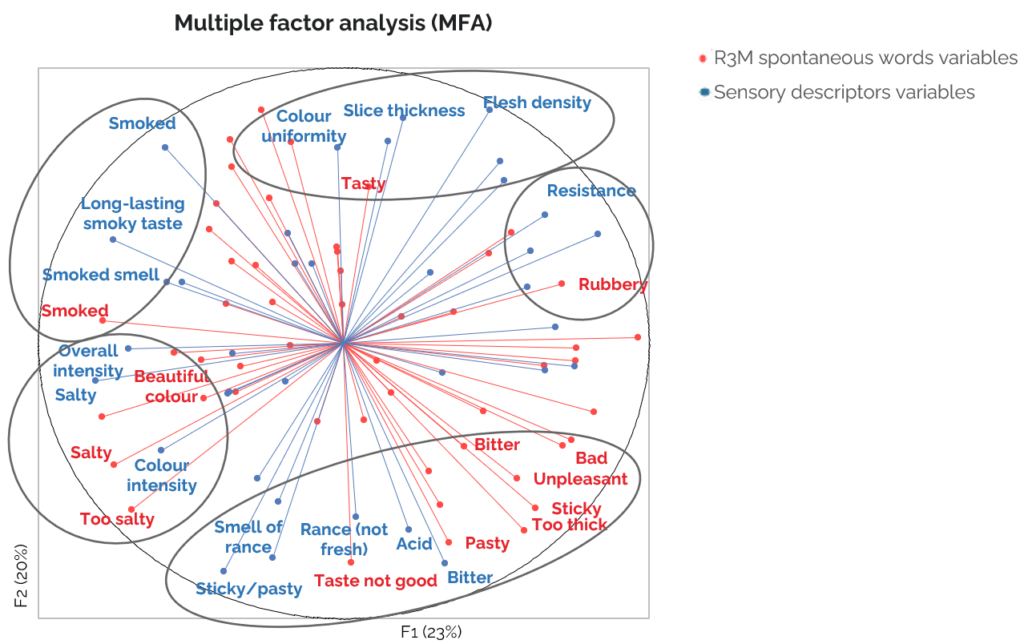Preference mapping or “prefmap” aims to establish links between the objective sensory characteristics of products (judged by a panel of experts) and consumer preferences. It serves as a guide for R&D to optimize formulations, by modeling the ideal sensory profile that maximizes consumer preferences.
Traditionally, prefmap is a highly technical and sensory method, leaving little room for consumer expression. Indeed, usually only the Liking question is used. However, we know that “preference” is a much more complex notion, influenced by sensations, emotions and unconscious automatisms.
In addition, it’s sometimes difficult to make the link between appreciation and the sensory reality of products. Since conventional questions (such as item grids) can be tedious and ineffective, why not use consumers’ spontaneous reactions?
By simply asking consumers: “What are the first three words that come to mind regarding this product?”, we gain access to a more emotional and spontaneous dimension of reaction.
This approach is inspired by the “System 1” theory of the brain, described by Daniel KAHNEMAN, which is dominated by emotion and automatism (whereas a judgmental question will position the respondent in a more rational and reflective posture closer to “System 2”).
The 3 spontaneous words are used to calculate an emotional activation score.
Each word collected is analyzed using the R3mScore algorithm, which takes into account several criteria (grammatical nature, descriptive or projective logic of the word, its valence, rank, association with which other words, in which context, etc.), translating a greater or lesser emotional intensity with regard to the tested product.
Thus, this activation score can complement or even replace the liking score as a solid quantitative indicator:
– built on a broad scale for high product dispersion and discrimination (few ex-aequo)
– limits the threshold effects of conventional scales (there are few limits with words: you can be “very good”, “excellent” or “extraordinary”, but it’s hard to be better than 9/10 or 10/10 on a 10-point scale).
Several preference mapping studies* have demonstrated that R3mScore is relevant and particularly effective, both for preference mapping modeling with sensory data as well as for consumer preference segmentation (clustering).
Consumers’ spontaneous words can also be used to decipher how they perceive products.
Using their own words, without long induced evaluation grids or imposed scales, consumers will quickly and simply identify the levers and brakes: what’s important to them, what makes an impact, what differentiates each product.
The R3mScore algorithm doesn’t just list these words, but identifies and ranks those that have the greatest impact, contributing the most to the overall emotional activation score (including weak signals) for greater differentiation and analytical finesse.
So, for each product tested, we’ll have a rich, precise, unbiased and discriminating consumer diagnosis, which will enable us to make the link with sensory profiles.
Indeed, we were able to demonstrate * a strong correlation between these spontaneous words (R3m Score) and the sensory evaluations of the experts.
In the statistical analysis below (AFM), we can see that there is a strong proximity between consumers’ words and sensory descriptors on the different dimensions. For example, a product described as “tasty” by consumers could be described by an expert as having a uniform color and a dense, thick texture.

Thanks to this approach, experts’ technical and specific descriptors can be translated into consumer language. This provides a better understanding of preferences and facilitates communication.
Thus, the recommendations resulting from a preference mapping study are more complete, linking the vision of experts and consumers for better-informed R&D and marketing decisions.
RECO#2 : OPERATIONAL AND ACTIONABLE SEGMENTATION OF PREFERENCE
* Several cases of preference mapping and segmenting have been carried out in the food and cosmetics sectors. More information on request via our contact form.
Any questions, any projects?
We are eager to discuss your business needs, and answer any questions you may have.